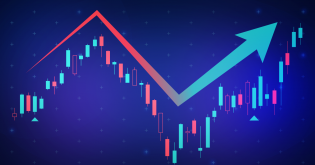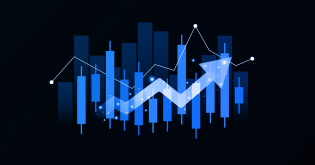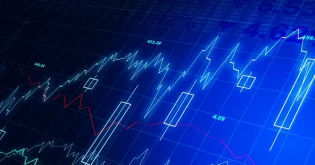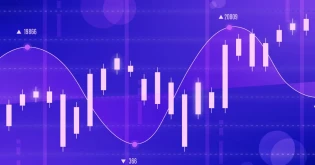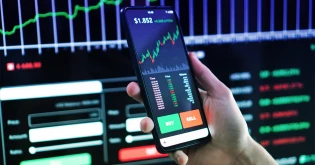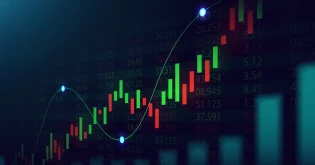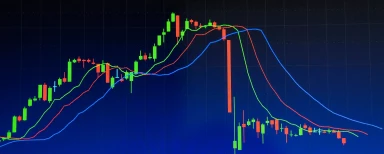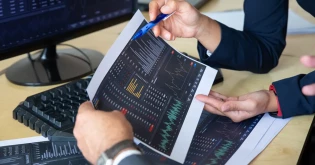-
The use of indicators is crucial while forex trading. Many traders use these indicators daily to help them determine when to buy and sell in the currency market. Any technical or fundamental analyst should be aware of these indications since they are a crucial component of technical analysis in trading.
Today, in this blog, we will explain the top Forex trading indicators offered by top currency trading platforms nowadays. So, let’s understand what every Forex trader should know. But before proceeding further, you should know what indicators are.
What Are Trading Indicators?
Trading indicators are tools used by investors to analyze financial markets. They help predict price movements of stocks, currencies, or commodities. Indicators include moving averages, MACD, and RSI. They show trends, momentum, and potential buy/sell signals. Traders use them to make informed decisions and manage risks in their investments.
Common Forex Trading Indicators
You can employ a plethora of Forex trading indicators. The list of tools that both novice and seasoned traders most frequently utilize is shown below. Please take what you can and incorporate it into your strategy.
- Moving Averages
- Relative Strength Index (RSI
- Bollinger Bands
- MACD (Moving Average Convergence Divergence)
Moving Averages
Moving averages represent the average closing price of a currency pair over a given time. It provides you with the average price at which decreasing prices halt and begin to rise, and vice versa.
In addition to highlighting areas of support and resistance, this indicator removes erroneous brief price swings, giving you an average price on which to build your exit and entrance plans.
Moving Averages Example
Moving Averages are essential indicators in Forex trading that help discover patterns by smoothing out price data over a given period. An instance would be a trader employing a simple moving average (SMA) to determine the average price of a currency pair over the preceding 50 days.
Plotting this against the current prices helps to highlight the trends and volatility. A price increase may be indicated if it crosses the SMA; a price decrease indicates a potential downturn. With the use of this analytical tool, traders are better able to predict future market trends by making well-informed decisions based on past price movements.
Relative Strength Index (RSI)
An additional oscillator that is used to determine overbought and oversold situations is the relative strength index (RSI). It calculates a market's gains from closed-up sessions and contrasts them with losses from closed-down ones. The computation is then shown as a reading between 0 and 100.
Trading only based on the RSI is typically not a smart idea, though, as markets can go overbought or sold off for extended periods without turning around. The RSI can also be used to detect divergences, which occur when the market is moving in the opposite direction but the RSI is rising or decreasing.
Relative Strength Index Example
The Relative Strength Index (RSI), a momentum oscillator used in Forex trading, gauges the velocities and changes in price movements. Signs of an impending reversal or correction may emerge when, for instance, the RSI of a currency pair climbs above 70, signaling overbuying.
Conversely, a dip below 30 in the RSI indicates oversold conditions, potentially heralding an upward surge in the market. The RSI serves as a valuable tool for traders to assess trend strength and identify potential entry and exit points. By integrating RSI analysis into their strategy, traders can bolster their trading proficiency and make more informed decisions.
Bollinger Bands
Bollinger bands are displayed as a series of lines on a chart and have a similar appearance to moving averages. Rather than averaging price fluctuations, they indicate the current level of market volatility. We accomplish this by plotting two lines, one on either side of the moving average (MA), and the other two standard deviations above or below it.
The standard deviation quantifies the degree to which a series deviates from its mean. Thus, a large distance between the Bollinger bands denotes considerable volatility. The bands will be close together in a tranquil market.
Signals of overbought and oversold conditions can also be produced using Bollinger bands. A market is perhaps overbought if it consistently tries the upper band; if it challenges the lower one, it might be oversold.
Bollinger Bands Example
Bollinger Bands are volatility indicators used in Forex trading. They are made up of a moving average with two bands, one above and one below it, that indicate standard deviations from the average. A reversal or correction may be indicated, for instance, if the price of a currency pair moves outside of the upper band, indicating that the pair is overbought.
On the other hand, if the price drops below the lower band, it suggests that the market is oversold and may even be a good time to buy. By using Bollinger Bands, traders can improve their trading techniques and decision-making processes by identifying times of high or low volatility, predicting price reversals, and establishing appropriate entry and exit points.
MACD (Moving Average Convergence Divergence)
One example of how an indicator can use price data to provide you with a more in-depth view of a market is the moving average convergence divergence or MACD. Since it is an oscillator, as opposed to the MA and EMA, which are superimposed upon the action, it shows up below the chart of a market.
Two moving averages are used to calculate the two lines that make up the MACD. An SMA typically has 12 periods, while an EMA typically has 26 periods.
Momentum is frequently measured using the MACD. Strong upward momentum is indicated when the MACD line is much above the signal line, and downward momentum is indicated when it is far below. Another way to spot the potential formation of a new trend is to search for crossings between the two lines.
MACD Example
A common technical analysis tool in forex trading, the Moving Average Convergence Divergence (MACD) is used to spot possible trends and reversals. We obtain the MACD line by comparing two exponential moving averages (EMA), typically a 12-period and a 26-period EMA.
A signal line also helps identify entry and exit locations; this is often a 9-period EMA of the MACD line. A bullish trend is indicated when the MACD line crosses above the signal line; a negative trend is shown when it crosses below. For more information, traders can also examine the MACD histogram, which shows the difference between the MACD line and the signal line.
Suggested read: Types of Forex Charts
Choosing the Right Trading Indicators
Choosing the perfect fit for your trading strategy requires careful consideration. Here we have mentioned the steps to help you select the right trading indicator on various Forex trading platforms:
Step 1: Understand Your Trading Style
Start the process by looking at your specific battleship and its goals. Is your strategy getting in and out smoothly regularly in search of short-term profits or do you usually asset-allocate more on a long-term basis with some patience? Using the indicators to which you are most comfortable and the time horizon, set the magnitude to where your risk appetite and risk tolerance are.
Step 2: Research and Experiment
Explore the myriad of choice metrics. Familiarize yourself with the process second before getting to the solutions. Practice using demo accounts and test out various ratios. Find a balance between keeping some of your investments and letting others grow and see how they perform in different market situations.
Step 3: Focus on Simplicity
In the reality of trading an investor gets used to the fact that it is a simple site that becomes the summit of hearing. Choose indicators that you can understand easily and that matches what you want to achieve with your trades. Understand the difference between complicated situations and urgent ones that need you to act fast.
Step 4: Consider Market Conditions
Indicators do not always perform pretty in all markets. One trade's star might be a star of ranging markets, while another might be a star in trending markets. Select indicators that are aligned based on the current market situation. The reason businesses have a logo is to help customers remember the brand.
Step 5: Refine and Adapt
The adventure of trading is always changing. Continue to keep an eye on and assess the performance of the indicators you have selected. Be ready to modify your strategy and adjust to shifting market conditions.
Factors to Consider When Selecting Indicators
Here are five crucial factors to consider when choosing your forex trading indicators when you trade FX online:
1. Accuracy and Reliability
The accuracy and reliability of the instrument constitute the prime issue. Address the referencing that makes sense and is rigorous and utilizes sound mathematics as an underlying theory. The backtesting process will enable you to discover how the indicator behaved in a variety of market scenarios, giving you insights into its reliable source of information.
2. Alignment with Trading Strategy
There is not even one trader who uses the same approach, whether it will be a trend following, mean reversion or breakout trading. Constant attention is key in selecting indicators and should align with the strategy's objectives. This means that if you're someone who likes to follow trends and moving averages, you might prefer looking at trailing ones. But if you're more into fast-changing market movements, indicators like RSI or Stochastic Oscillators might be better for you.
3. Ease of Interpretation
In a world where forex trading has to be done at incredible speeds, the key issues to successful trading are clarity and simplicity. Select Indicators that are easy to organize and give obvious indicators. Indicators with arithmetical complications and limited applications can make you put off trading or even lose the unique chance.
4. Compatibility With Timeframes
Forex technical markets can take place within minutes and sometimes even day traders can plan such deals. Sure you are the chosen indicators are compatible with your chosen timeframe. Some of the features may be performing better for hourly cycles, which capture intra-day fluctuations across the day, and others may be more suitable for deals with longer-term analysis.
5. Market Conditions and Volatility
The difference between how the market changes and how trading indicators move can be big. For example, numbers might look good when prices are going up and down a lot, but they don't make as much sense when prices are staying about the same or moving randomly. Given the market environment, you should be choosy of factors that can easily and constantly update with changing seasons.
Tips for Using Trading Indicators Effectively
Such a leading idea is that these four indicators are capable of currency trading. This is the pivotal part in exploring the development of the business that helps in realizing the dynamics of the industry, and in determining trends and choices to be informed well. Nevertheless, it should be kept in mind that there is no simple single or dependable signal or combination for these.
To maximize the four Forex trading indicators that were previously discussed, keep the following tips in mind before you begin your trading forex online journey:
- Commence with a Robust Basis: So, if Forex traders yield to the above indicators, they have solid ground to be on. First, ensure you are conversant with the indicators and start with simple techniques before progressing to the more difficult ones.
- Refrain from Overcomplicating: Putting in too many extra features and indicators might seem helpful, but it can actually confuse the reader and make them see things differently. When making a chart, make sure it's clear and stays the same throughout.
- Backtest and Try: Risking real money would be out of the question, so you can work with these strategies on a demo account to see. Now you are not restricted financially in where you want to spend so much of your time allowing you to use the time more effectively improving your business plan and your knowledge.
- Tailor to Your Style: Choose those reminders to fit you as a trader, your attitude to risk, and the trade duration periods. Make the necessary adjustments; what plays out for one trader may inevitably play the contrary for another.
Conclusion
As we finish learning about Forex trading indicators, it's clear that there's more to it than just looking at graphs and numbers. Above in this blog, we have discussed different indicators, like Moving Averages, Bollinger Bands, and more. It's not just about knowing the technical stuff, but also trusting your gut feeling.
Even though it can be complicated, the most important thing is for traders to be flexible, keep learning, and get better over time. Tips for using indicators effectively remind us that success in Forex trading isn't just about using fancy computer programs. It's also about understanding people, being tough when things get hard, and always trying to get better in this ever-changing world of trading.

